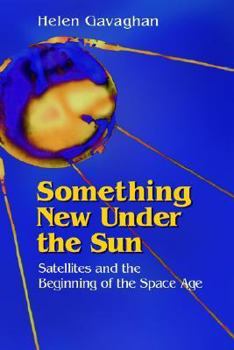Something New Under the Sun: Satellites and the Beginning of the Space Age
Select Format
Select Condition 
Book Overview
In this, the first history of artifical satellites and their uses, Helen Gavaghan shows how the idea of putting an object in orbit around the earth changed from science fiction to indespensible technology in the twinkling of an eye. Thanks to satellites, we can now send data and images anywhere in the world in an instant. The satellite-based navigational system can pinpoint your exact location anywhere in the world; it is so precise that, from outer space, it can detect the sag on an airplane's wing. Focusing on three major areas of development - navigational satellites, communications, and weather observation and forecasting - Gavaghan tells the remarkable inside story of how obscure men and women, often laboring under strict secrecy, made the extraordinary scientific and technological discoveries needed to make these miracles happen. Written by a science journalist with support from the Sloane Foundation, the book describes the birth of the modern scientific era in the twentieth century, with creation of satellite technology. The narrative is part history - beginning with the Russian-U.S. contest with the launch of Sputnik; part politics, as scientists and visionary engineers compete for scarce funding that will bring their dreams to reality; partly the story of the singular and fascinating individuals who were present at the creation of our modern technological era.
Format:Hardcover
Language:English
ISBN:0387949143
ISBN13:9780387949147
Release Date:November 1997
Publisher:Copernicus Books
Length:300 Pages
Weight:1.45 lbs.
Dimensions:1.0" x 6.5" x 9.4"
Customer Reviews
1 rating
A unique history - I only wish there was more!
Published by Thriftbooks.com User , 26 years ago
I really enjoyed this book's combination of technical (but not too technical) and personal detail. Not only did the book cover the birth and infancy of satellite technology it gave us a good luck at the personalities behind it. My criticism is that the book doesn't go far enough - it doesn't bring the story up to the present day. I realize that this is a daunting task but it would be useful to provide a context - to examine how far we've come. For example, a comparison of modern satellites and their predecessors would be very telling. The book examines just the initial years - more information on satellite development in the 60's and early '70s would put things in a better perspective. On a minor note, I would have preferred a standard bibliograpy and footnotes rather than the detailed bibliography that we're confronted with. There have been many books written about the early manned space program but not enough written on early unmanned efforts. And among those books, most focus on the interplanetary probes, making this book a welcome addition to the study of man's early forays into space.






